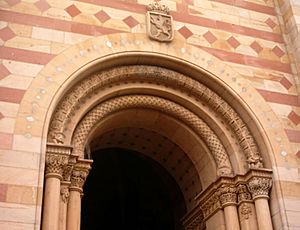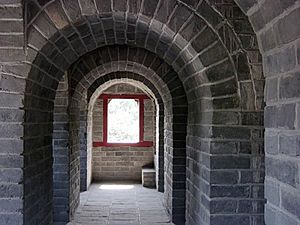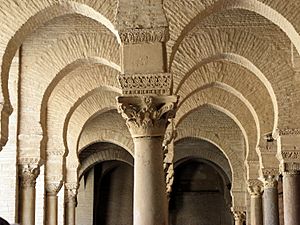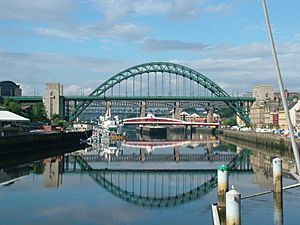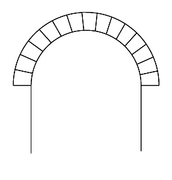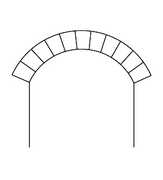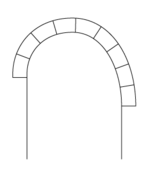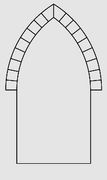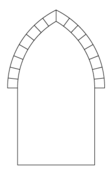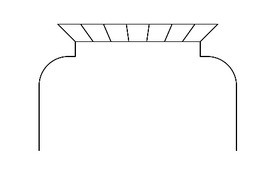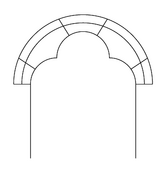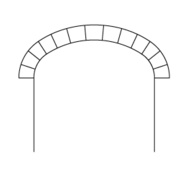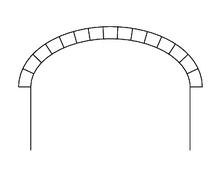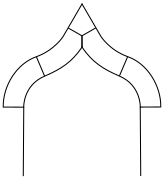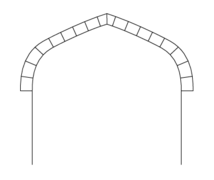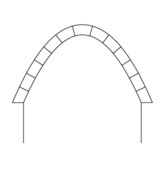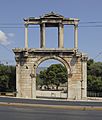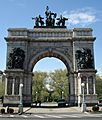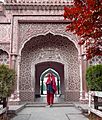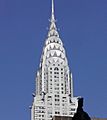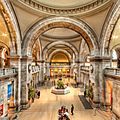Arch facts for kids
An arch is a curved opening in a building. It can be round, like part of a circle, or pointed, like two curved lines meeting at the top. Arches are often used in buildings made from many small stones or bricks. The special stone at the very top of the arch is called the keystone. It helps hold all the other stones in place so the arch doesn't fall down. Arches are commonly found over doorways and windows. Many bridges are also built using arches.
Contents
How Arches Work
An arch is very strong because it handles forces by squeezing them together. This is called compressive stress. It helps the arch span a large space without being pulled apart. When an arch carries weight, it pushes outwards at its base. This outward push is called "thrust." If an arch is flatter (less tall), the outward thrust becomes stronger. To stop the arch from collapsing, this thrust needs to be held back. This can be done with strong supports on the sides, called abutments, or with hidden ties inside the structure.
Different Kinds of Arches
There are three main types of true arches: the fixed arch, the two-hinged arch, and the three-hinged arch. They are different in how they are connected and how they handle changes.
A fixed arch is often used in concrete bridges and tunnels that don't span very far. This type of arch is very stiff. It can get extra stress when the temperature changes, causing it to expand or shrink.
The two-hinged arch is often used for longer bridges. It has special connections at its base that act like pins. These pinned bases can rotate a little. This allows the arch to move freely and adjust to temperature changes. This movement helps reduce some of the stress that a fixed arch would experience.
The three-hinged arch is hinged not only at its base but also in the middle. This extra hinge allows the arch to move even more. It can adjust easily to any expansion or shrinking caused by temperature changes. Because of this, the three-hinged arch doesn't get extra stress from temperature shifts. It's often used for medium-sized structures, like large building roofs. Another good thing about three-hinged arches is that their pinned bases are easier to build. This means they can use simpler foundations.
Shapes of Arches
Arches come in many shapes, but they fit into three main groups: circular, pointed, and parabolic. Arches can also be put together to create vaults (curved ceilings) and arcades (a row of arches).
Circular arches, also called rounded arches, were popular with ancient builders, especially the Romans. They used these arches a lot to span wide open areas. When several rounded arches are placed in a line, one after another, they form an arcade, like the famous Roman aqueducts.
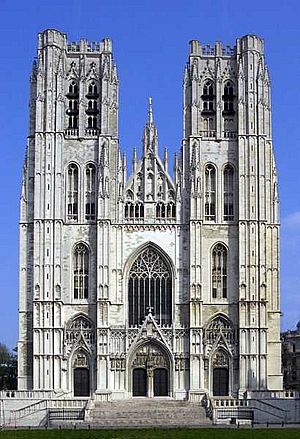
Pointed arches were mostly used in Gothic architecture. The great thing about a pointed arch is that it creates less outward push at its base. This clever design allowed builders to create much taller and closer-together openings, which is a key feature of Gothic buildings.
Vaults are basically many arches placed side-by-side. When vaults cross each other, they create complex and beautiful shapes. The strong lines where these vaults meet were a very important part of the look of Gothic cathedrals.
The parabolic arch is designed so that if weight is spread evenly across it, the squeezing force inside the arch follows a parabolic curve. Parabolic arches create the most outward push at their base, but they can span the largest areas. They are often used in bridge design when very long spans are needed.
The catenary arch has a unique shape, like a loose chain hanging between two points. This shape is considered the best for a freestanding arch that has the same thickness all the way around.
Here are different types of arches, shown in the order they were generally developed:
Other Types of Arches
A blind arch is an arch that is filled in with solid material. It can't be used as a window, door, or walkway.
A special kind of arch is the triumphal arch. These are usually built to celebrate a victory in a war. A famous example is the Arc de Triomphe in Paris, France.
Some arches are not built by people but are formed naturally by erosion of rock. These are called natural arches. You can find many of these amazing structures in places like Arches National Park.
Sometimes, people create art by balancing rocks in the shape of an arch. These are called rock balance sculptures.
Even the human body has arches! The arches of the foot help support your body's weight when you stand and walk.
Images for kids
-
Roman aqueduct near Nîmes, France: an arcade, employing the circular arch
-
Depressed Tudor arch on Layer Marney Tower in Essex, England
-
Washington Square Arch, a triumphal arch in Greenwich Village, Manhattan, New York City
-
Delicate Arch, a natural arch in Arches National Park near Moab, Utah
-
Medial longitudinal arch of the human foot (Gray's Anatomy)
-
Restored Canaanite city gate of Ashkelon, Ashkelon, Israel (2014)
-
Arch of Augustus, Rimini, Emilia-Romagna, Italy (2015)
-
Arch of Gallienus, Rome (2006)
-
Arch of Hadrian, Athens, Greece (2013)
-
Arch of Constantine, Rome, commemorating a victory by Constantine I in 312 AD (2007)
-
The Arc de Triomphe, Paris; a 19th-century triumphal arch modelled on the classical Roman design (1998)
-
Soldiers' and Sailors' Arch in the Grand Army Plaza, Brooklyn, New York City (2007)
-
Gateway Arch in St. Louis, Missouri; a monument based on a catenary arch (2011)
-
The Theme Building at Los Angeles International Airport, California
-
Pont Flavien over the River Touloubre in Saint-Chamas, Bouches-du-Rhône, France (2008)
-
Old stone bridge in Kerava, Finland (2011)
-
Bridge of Seonamsa Temple, Suncheon, South Jeolla Province, South Korea (1979)
-
Union Arch Bridge carrying the Washington Aqueduct and MacArthur Boulevard (formerly named Conduit Road) in Cabin John, Montgomery County, Maryland (2008)
-
Anji Bridge over the Xiaohe River, Hebei Province, China (2007)
-
The dry stone bridge, so called Porta Rosa (4th century BC), in Elea, Province of Salerno, Campania, Italy (2005)
-
Bridge of Sighs, Venice, Italy (2001)
-
Pont du Gard, a Roman aqueduct in Vers-Pont-du-Gard, Gard, France (2014)
-
Rialto Bridge over the Grand Canal in Venice, Italy (2011)
-
Pont de Bercy over the River Seine, Paris, carrying the Paris Métro on its upper deck and a boulevard extension on its lower deck (2006)
-
Arlington Memorial Bridge over the Potomac River in Washington, D.C. (2007)
-
Francis Scott Key Bridge over the Potomac River in Washington, D.C. (2006)
-
Woodrow Wilson Memorial Bridge carrying Interstate 95 (I-95) and the Capital Beltway over the Potomac River between Alexandria, Virginia and Oxon Hill, Maryland (2007)
-
Arrábida Bridge over the Douro River connecting Porto, and Vila Nova de Gaia, in the Norte Region, Portugal (2011)
-
Rainbow Bridge over the Niagara River connecting Niagara Falls, New York and Niagara Falls, Ontario, Canada (2012)
-
Hell Gate Bridge over the East River, New York City
-
Sydney Harbour Bridge, Sydney, New South Wales, Australia (2010)
-
Ludendorff Bridge over the Rhine River, Remagen, Germany, showing damage before collapse during the Battle of Remagen in World War II (1945)
-
Lianxiang bridge over the Xiang River, Xiangtan, Hunan Province, China (2007)
-
Zhivopisny Bridge over the Moskva River, Moscow, Russia (2009)
-
Margaret Hunt Hill Bridge over the Trinity River in Dallas, Texas (2012)
-
Juscelino Kubitschek Bridge crossing Paranoá Lake, Brasília, Brazil (2007)
-
Gateshead Millennium Bridge over the River Tyne, Newcastle upon Tyne, England, UK (2005)
-
Eiffel Tower, Paris (2009)
-
Arch supporting the Eiffel Tower, Paris (2015)
-
The second Wembley Stadium in London, built in 2007 (2007)
-
The first San Mamés Stadium, in Bilbao, arch built in 1953, demolished 2013 (2013)
-
St Pancras railway station, London (2011)
-
Train shed in St Pancras railway station, London (2010)
-
Train shed in Victoria Station, London (2006)
-
Lucerne railway station, Switzerland (2010)
-
Central railway station, Frankfurt, Germany (2008)
-
Train shed in Central railway station, Frankfurt, Germany (2005)
-
Arches in Main Concourse, Grand Central Terminal, Manhattan, New York City (2014)
-
Interior arches in Washington Union Station, Washington, D.C. (2006)
-
Arches in Great Hall, Chicago Union Station, Chicago, Illinois (2010)
-
Haus der Kulturen der Welt, Berlin, Germany (2011)
-
Arches in the Casa-Museo del Libertador Simón Bolívar in Havana, Cuba (2006)
-
Arches in dining hall at Kings College, University of Cambridge, Cambridge, England (2007)
-
Arches inside Annenberg Hall, Memorial Hall, Harvard University, Cambridge, Massachusetts (2016)
-
Arches in throne room of Neuschwanstein Castle, Bavaria, Germany (1886 photochrom print)
-
Arches in the Court of the Lions, Alhambra, Granada, Andalusia, Spain (2012)
-
External arches in the Court of the Myrtles, Alhambra, Granada, Andalusia, Spain (2009)
-
Arches inside the North Gallery, Court of the Myrtles, Alhambra, Granada, Andalusia, Spain (2010)
-
North facade of Chartres Cathedral, Chartres, France (2008)
-
Arches in choir of Chartres Cathedral, Chartres, France (2013)
-
Arches in nave of Westminster Abbey, City of Westminster, London (2006)
-
Arches inside the Washington National Cathedral, Washington, D.C. (2005)
-
Interior arches in St. Peter's Basilica, Vatican City (2009)
-
Hagia Sophia in Istanbul, Turkey (2013)
-
Arches inside the Hagia Sophia in Istanbul, Turkey (1983)
-
Arches inside the western upper gallery, Hagia Sophia, Istanbul, Turkey (2007)
-
Interior arches in the Masjid al-Haram, Mecca, Saudi Arabia (2008)
-
Roof of Masjid al-Haram, Mecca, Saudi Arabia (2008)
-
Arches inside the Dome of the Rock, Old City of Jerusalem (2014)
-
Arches in the Shahi Mosque, Chitral, Khyber Pakhtunkhwa province, Pakistan (2016)
-
Taj Mahal in Agra, Uttar Pradesh, India (2009)
-
The Great Gate (Darwaza-i-rauza): Entrance to grounds of Taj Mahal, Agra, Uttar Pradesh, India (2004)
-
Arches inside the Taj Majal, Agra, Uttar Pradesh, India
-
Arches in Main Reading Room, Thomas Jefferson Building, Library of Congress, Washington, D.C. (2009)
-
Arches in Great Hall, Thomas Jefferson Building, Library of Congress, Washington, D.C. (2007)
-
Art Deco arches on Chrysler Building, Manhattan, New York City (2005)
-
Arches inside the entrance of New York Public Library Main Branch, Manhattan, New York City (2012)
-
Arches in Great Hall, Metropolitan Museum of Art, Manhattan, New York City (2012)
-
Arches in Sculpture Gallery, West Building, National Gallery of Art, Washington, D.C. (2007)
-
Arches inside the Legion of Honor, Lincoln Park, San Francisco, California (2010)
-
Arches near the Jordan Staircase, Winter Palace, Hermitage Museum, St. Petersburg, Russia (2015)
-
Arches in Pavilion Hall, Small Hermitage, Hermitage Museum, St. Petersburg, Russia (2015)
-
Arches in Salle du Manège, Louvre Palace, Paris (2007)
-
Arches in Galerie des Batailles, Palace of Versailles, Versailles, Yvelines, France (2013)
-
Arches in Hall of Mirrors, Palace of Versailles, Versailles, Yvelines, France (2011)
-
Arches in Westminster Hall, Palace of Westminster, City of Westminster, London (2011)
-
Arches in St. Stevens Hall, Palace of Westminster, City of Westminster, London (2007)
-
Horseshoe arch inside the Aljafería Palace, Zaragoza, Spain (2004)
-
Multifoil arches inside the Aljafería Palace, Zaragoza, Spain (2004)
-
Catenary arches inside the Casa Milà in Barcelona, Spain by Antoni Gaudí (2010}
-
Rajasthani style arches inside the 16th-century City Palace, Udaipur, India (2013)
-
Arches inside the National Building Museum (formerly Pension Building), Washington, D.C. (2007)
-
Front entrance of the Old Post Office Building in Washington, D.C. (2006)
-
Arches inside the Old Post Office Building in Washington, D.C. (2009)
-
Bankstown Reservoir, Bankstown, Sydney, New South Wales, Australia (2018)
-
Crypt of the Popes in the Catacomb of Callixtus, Rome (2007)
-
Chinese Eastern Han Dynasty (25–220 AD) tomb chamber, Luoyang (2008)
-
Entrance to Washington family tomb at Mount Vernon, Fairfax County, Virginia (2014)
-
Natural Bridge in Rockbridge County, Virginia (2014)
-
Jiangzhou Natural Bridge, Guangxi Zhuang Autonomous Region, China (2012)
-
Landscape Arch, Arches National Park, Utah (2016)
-
Double O Arch, Arches National Park, Utah (2007)
-
Aloba Arch, Ennedi-Est Region, Chad (2015)
-
Shipton's Arch, Xinjiang Uygur Autonomous Region, China (2011)
-
Darwin's Arch, Galápagos Archipelago, Pacific Ocean (2006)
-
Shah Abbas Arch Dam (Tagh E Shah Abbas), Tabas County, South Khorasan Province, Iran (2011)
-
Hoover Dam in the Black Canyon of the Colorado River, Clark County, Nevada and Mohave County, Arizona (2017)
-
El Atazar Dam on the Lozoya River near Madrid, Spain (2014)
See also
 In Spanish: Arco (arquitectura) para niños
In Spanish: Arco (arquitectura) para niños


